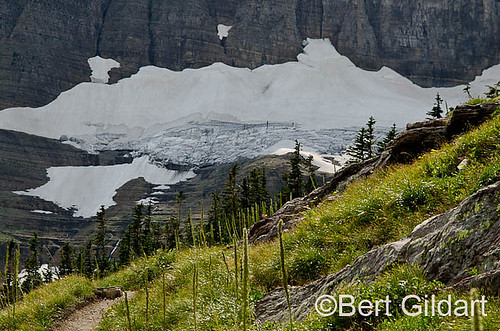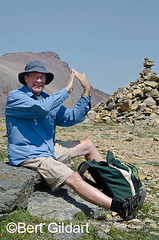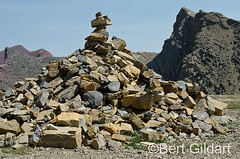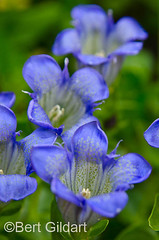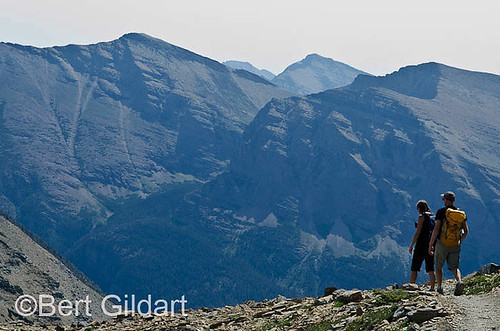Sexton Glacier, One of the Park’s Last
©Bert Gildart: This past Friday Matt Rigg, one of my best hiking buddies, and I hiked to Siyeh Pass along a trail that is essentially a 10-mile loop. The trail is a challenging one and ascends several thousand feet; but as it courses it winds through one of the park’s most incredible alpine areas. In June glacier lilies carpet the landscape and they in turn attract grizzly bears, who bulldoze their way to the species’ delicious bulbs.
In August, the landscape is still lush with wildflowers, and as we hiked we saw the crimson-colored monkey flower, the lavishly fringed silky phacelia – and the trumpet-shaped gentian with its deep shades of blue.
ONE OF THE LAST
Beautiful as the immediate landscape was for me the hike was climaxed by the sprawl of one of the park’s last remaining sheets of ice, Sexton Glacier.
Matt Rigg dramatizing a successful climb; cairn at summit of climb; blue gentian
The glacier is a beautiful one, but it has vastly diminished in size since I first saw it back in the ‘60s. And it’s not alone! In the past 100-plus years Glacier Park has chronicled not just the recession of many of its glaciers, but their actual disappearance. In 1910 the embryonic park hosted 150 glaciers. But since that time world temperatures have risen dramatically, and, today, glaciers in this park number but 26.
EIGHT YEARS REMAINING
Park scientists say glaciers are much like a canary in a mine and their disappearance portend much changes. They serve as water reservoirs, and tell us as well that we should expect to see major changes in the makeup of the park’s flora and fauna. Park climatologist Dr. Dan Fagre believes all glaciers in the park will disappear in just eight more years, and over the years I’ve reported on some of the expectation for a variety of publications.
Though the massive ice sheets that once graced Glacier are retreating, Matt and I agreed that because so many of the park’s major features were created by the power of moving ice (moraines, arêtes, hanging gardens, etc.) that there should never be a park name-change. In other words, it will always be appropriate to call the million-plus acres comprising this area: Glacier National Park.
And so we hiked on, complacent in the knowledge that decisions that will affect the world lie with the next generation. About all we could do is enjoy the here and the now and the overwhelming beauty of the few glaciers that still exist in the year 2012.
Vast fields of flowers and Sexton Glacier made it easy to do just that.
—————————————————————
Airstream Travels Last Summer
*Floating Montana’s Wild & Scenic Missouri River
ADS FROM AMAZON AND GOOGLE AUGMENT OUR TRAVELS
(You can order our new books (shown below ) from Amazon or you can order them directly from the Gildarts. Bert will knock a dollar off the list price of $16.95, but he must add the cost of book-rate mailing and the mailer, which are $2.25. The grand total then is $18.20. Please send checks to Bert Gildart at 1676 Riverside Road, Bigfork, MT 59911.)
